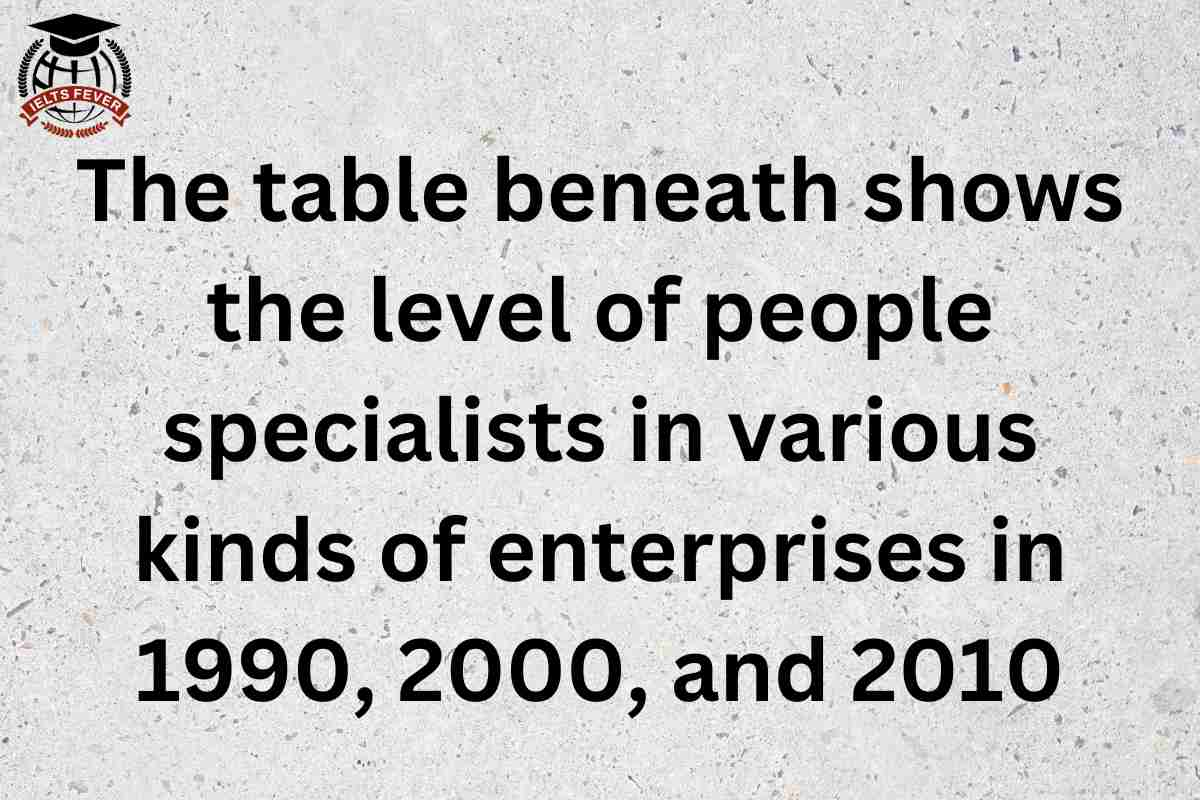The table beneath shows the level of people specialists in various kinds of enterprises in 1990, 2000, and 2010. Sum up the data by choosing and writing about the primary capacities and make correlations where fitting.
The rendered tabular chart illustrates the remarkable information regarding the ratio of men and women who were specialists in various kinds of working fields from 1990 to 2010. The data has been calibrated in percentages.
Overall, it can be manifested that the majority of the percentage increased in health and retails every given year for both groups whereas manufacturing shrinks down as other departments.
Looking at the table chart, in the retail enterprises, the percentage of males was similar in all three given years. At the same time, women were noticed at 7% in 1990, 8% in 2000 and 9% in 2010, respectively.
Moreover, 7% of men were health specialists in 1990 and 2000, but the ratio increased by 2% more in the latter year. While the percentage of women’s had the highest in the health department as compared to men’s.
Moving to the rest of the data, the majority of males were specialists in manufacturing, which was 30% in the initial year, but the trend decreased in the other two years. Whereas females were less interested in manufacturing which was 7% in 1990, 8% in 2000 and only 3% noticed in 2010. Additionally, 13% of men’s specialists were in tourism in 1990, and in another two given years, the ratio was only 10%. Surprisingly, nearly one-quarter of women are specialists in tourism as compared to other kinds of enterprises in the given years.
Sample 2 The Table Beneath Shows the Level of People Specialists in Various Kinds
The tabular chart is straight information about the level of both males and females who were experts in several types of businesses in 1990, 2000 and 2010.
Overall it can be seen that the manufacturing sector had the highest ratio of men and specialists, whereas the highest number of women experts could be seen in the tourism industry in the period of two decades, the percentage of women specialists rose gradually.
In-depth analysis, it can be clear that in the manufacturing process, the proportion of men employees was 30% in 1990 and 7% of females were employed in manufacturing in 1990, but in 2010 the percentage of figures increased in both genders, which were 10% and 3% respectively. In the retail sector, the ratio of men remained stable at 30% over the gate while the ratio of female employees rose from 7% to 9% throughout the period.
In regard to further details in the tourism Industry, although the proportion of male experts decreased from 13% to 10% in the given period of the year yet the ratio of females specialised rows from just under the quarter to over the quarter in 1990 the percentage of male employees in the health sector at 7% while the figure of female employees was 9%. In 2010, both genders witnessed an increase of 9% and 15% respectively.
Sample 3 The Table Beneath Shows the Level of People Specialists in Various Kinds
The table chart compares the percentage of men and women specialists in four distinct factors: retail, health, manufacturing and tourism, in the years 1990, 2002 and 2010.
Overall, it is readily apparent that throughout the period, the percentage of men of retail specialists remained identical. Over the period, the proportion of women specialists in tourism factor was very high and increased gradually from 1990 to 2010.
With regard to men, for the retail sector, men specialists remained stable, which was 13 %. Throughout the period, men’s specialists in the health field were 7% in 1990, but it increased slightly to 9% in 2010. From 1990 to 2010, manufacturing specialist man was at the highest peak at 30%, which plummeted to 10% in 2010. In the tourism sector, men who are specialists was around 13% in 1990, but in 2000 and 2010, it decreased slightly and remained the same for both years.
With regard to women, who are specialists in retail, the factor was 7% in 1990, and it increased in the following year and reached 9% in 2010. There was a surge in women specialists in health from 9% to 15%. Over the period, manufacturing specialist women declined to 3% from the year 1990 to 2010. The highest proportion of women are specialists in tourism, which was 23%, 25% and 27% in 1990, 2000 and 2010, respectively.
Pages Content

